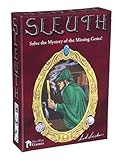

Components
- 36 Gem Cards
- 54 Search Cards
- 1 Pad of Information Sheets
Cards
Sleuth is played with two special decks of cards:
Gem Deck
The Gem Deck consists of 36 cards, each featuring a different combination of three elements: gem (diamond, pearl or opal), type (solitaire, pair or cluster) and color (red, blue, green or yellow).

Search Deck
The Search Deck consists of 54 cards that are used for gathering evidence from other players. There are three primary types: 1) One Element Cards which feature a gem, a type or a color, 2) Two Element Cards which feature a combination of any two elements, and 3) Free Choice Cards.

Object of the Game
Sleuth is a fascinating detective game for 3 to 7 players. Through skillful questioning of his opponents, each player gathers evidence and then, using his powers of deduction and logic, attempts to discover the identity of the missing gem!
Setup
Each player receives an Information Sheet and uses it to keep track of evidence gathered during the game. Players keep evidence secret by folding the sheet in half.
Dealer shuffles the Gem Deck and removes one card, placing it where no player may accidentally see it. This becomes the Missing Gem. The following number of cards are then dealt face down to each player:
- 3 players - 11 cards
- 4 players - 8 cards
- 5 players - 7 cards
- 6 players - 5 cards
- 7 players - 5 cards
Remaining gem cards (if any) are placed face up in the center of the table. On their Information Sheets, all players record the identity of cards in the center of the table. These cards are then set aside for the remainder of the game.
After picking up their hand, each player secretly records the identity of their own cards.
Example: In a five-player game, Player A was dealt the following cards: Red Diamond Cluster, Blue Diamond Pair, Green Diamond Pair, Green Pearl Pair, Green Pearl Cluster, Blue Opal Pair, and Yellow Pearl Cluster.
He recorded the identity of these cards on his Information Sheet as shown below.
The Search Deck is shuffled and four cards are dealt face up to each player (as illustrated on back cover of game box). The remaining cards are placed face down in the center of the table to form the Drawing Deck.
Play begins with player to the dealer's left and rotates clockwise.
Game Play
During the game, players obtain clues to the identity of the missing gem by interrogating other players. During each turn, a player may interrogate one opponent.
To do so, the player places one of his Search Cards face up in the center of the table. He may use either a One Element Card, a Two Element Card or a Free Choice Card as follows:

One Element Cards
When using a One Element Card, a player may interrogate any opponent by asking them to state how many Gem Cards he holds featuring that element. The chosen opponent must announce the number to all players.
Example: The Search Card used reads "Pairs" and the chosen opponent holds the Blue Diamond Pair, Yellow Pearl Pair, and the Green Pearl Pair. The player must announce that he has three pairs.
Two Element Cards
When using a Two Element Card, the interrogator may ask any opponent to pass over all Gem Cards they hold featuring that combination of elements.
The opponent passes over the cards (if any), face down, at the same time announcing the number to all players. The interrogator then records the identity of the cards and returns them to the opponent.

Example: The Search Card used reads "Blue Opals" and the opponent has the Blue Opal Solitaire and the Blue Opal Cluster.
The opponent passes these cards face down to the interrogator, at the same time announcing that he is passing two cards.
The interrogator returns both cards face down after recording their identity on his Information Sheet.
Free Choice Cards
There are two kinds of Free Choice Cards. Either may be used as a One or Two Element Card. If used as a Two Element Card, the interrogator may not combine two of the same elements (2 gems, 2 types, 2 colors).
When using the Free Choice card shown on the left, the interrogator may choose any combination of two different elements. When using the Free Choice Blues card shown on the right, the interrogator must use the element featured on the card. If used as a Two Element Card, the interrogator chooses an element to combine with the blues element featured on the card.
Example: The Search Card "Free Choice Blues" may be used to ask an opponent the number of Blue Cards they hold, or to see their Blue Diamonds, or their Blue Clusters, etc...
Turn End
At the end of their turn, the interrogator draws a Search Card from the deck to replace the one just used and play rotates clockwise. If the Drawing Deck is depleted, the Search Cards are reshuffled and placed face down in the center of the table.
Instead of interrogating an opponent, a player may use their turn to exchange their Search Cards. To do so, the player discards all four of his Search Cards, and replaces them with four cards from the Drawing Deck.
Identifying the Missing Gem
If a player believes he can identify the missing gem without further interrogation, he may do so at any time, not having to wait for his turn.
If, however, that player believes interrogating a certain opponent will enable him to identify the missing gem, he may, on his turn, ask any question of that opponent regardless of the Search Cards he has before him. The player must then attempt to identify the gem.
To identify the missing gem, the player circles the corresponding space on his Information Sheet and announces that he has solved the mystery. Play immediately stops; no other player may announce that they have solved the mystery until after the first player has verified his solution.
To verify this solution, the player secretly checks the missing gem card and:
If correct, reveals the card by turning it face up for all players to see and is declared the winner.
If incorrect, replaces the missing gem and the game continues. This player is now out of contention and must continue answering any interrogations while not otherwise participating in the game.
End of the Game
The game ends when one player correctly identifies the missing gem.
Strategy Tips
As experience is gained, players will develop their own methods of recording evidence and other pertinent data on their Information Sheets. It is essential to record who has a particular card and who cannot possibly have a certain card (such as when a player announces he has no Blue Pearls).
Every time a player is interrogated all players gain information from the number of cards announced. A piece of information that is useless at the time it is received may become crucial in combination with later evidence.
Example: A player asks for an opponent's Pearl Clusters and has two cards passed to him. You have the Blue Pearl Cluster in your hand. Later, the Yellow Pearl Cluster is passed to you. Since there are only four Pearl Cluster Cards, you know the previously passed cards must be the Red Pearl Cluster and the Green Pearl Cluster and record this information as evidence.
Continue Reading




